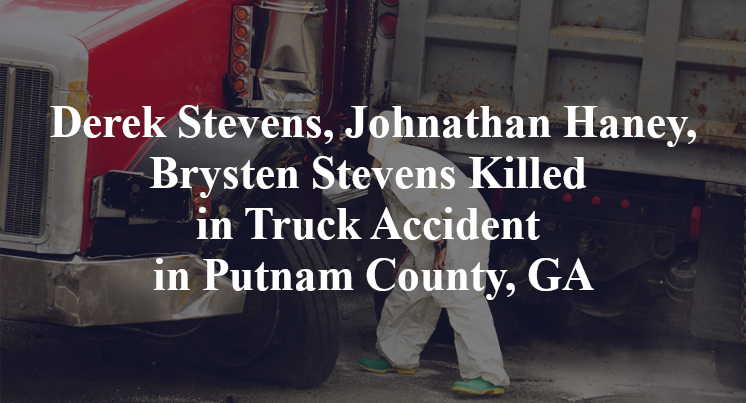Derek Stevens, Johnathan Haney, Brysten Stevens Killed in Truck Accident in Putnam County, GA
Update (April 25, 2025): Authorities have identified the three men killed in this accident as pickup driver Derek William Stevens, 35, and passengers Johnathan Tyler Haney, 25, and Brysten David Lee Stevens, 18.
Putnam County, GA — April 24, 2025, three people were killed in a truck accident at about 9:55 a.m. on U.S. Route 411 south of Eatonton.
Authorities said a semi-truck was stopped at a traffic light at the intersection with Pea Ridge Road/Twin Bridges Road when it was hit from behind by a Ram pickup hauling a trailer loaded with commercial air conditioning equipment. Witnesses estimated the pickup was traveling about 60 mph at the time of the crash.

All three people in the pickup died in the crash, according to authorities. Their names have not been made public at this point.
The truck driver was not injured.
Authorities have not released any additional information about the Putnam County crash. The accident is still under investigation.
Commentary by Attorney Michael Grossman
When a pickup hauling a commercial load crashes into the rear of a stopped semi-truck at highway speed, the outcome is nearly always catastrophic. But legally, the focus can’t stop at the assumption that the driver of the pickup simply failed to brake. In crashes like this, where a commercial vehicle is involved and multiple lives are lost, the law demands a closer look at all the circumstances, starting with whether the stopped semi-truck was as visible and safely positioned as it should have been.
A truck stopped at a traffic light on a rural or semi-rural highway must meet a high standard of visibility, particularly in daylight conditions. That includes functioning brake lights, clean reflective tape and clear trailer markings. Investigators will need to confirm that all of these were in working order, because if even one was missing or obscured, it could have made it more difficult for the pickup driver to perceive the truck as a stopped vehicle rather than one moving slowly through the intersection.
That said, the most pressing legal questions center on the pickup’s speed and the driver’s attention leading up to the crash. Witness accounts suggesting the vehicle was traveling around 60 mph indicate there was likely little or no attempt to stop. That points to the possibility of distraction, fatigue or some kind of medical emergency; conditions that are especially dangerous when hauling a trailer loaded with heavy commercial equipment.
Commercial loads like air conditioning units change the handling and stopping characteristics of a pickup significantly. The added weight increases stopping distance and makes it more difficult to make quick adjustments. Whoever was responsible for the trailer — whether the driver, employer or another party — had a duty to ensure it was properly secured and that the driver was fit to operate the vehicle safely under load. Investigators will likely be looking into who owned the equipment, whether the trailer was roadworthy and whether the driver had experience handling that kind of cargo.
It’s also worth asking whether the traffic signal at that intersection provides adequate warning to approaching drivers. Are there advance warning signs? Is the light visible from a sufficient distance? Rural intersections sometimes don’t give drivers the kind of visual cues they need to recognize a traffic light in time to respond, particularly if the view is obstructed by curves, hills or other vehicles.
Ultimately, a crash like this demands more than a straightforward explanation. When a commercial load collides with a commercial truck and multiple people lose their lives, it signals that something failed long before the moment of impact. Whether that failure lies with equipment, awareness or oversight, the investigation has to dig deep enough to answer a simple but essential question: why did a fully loaded vehicle with three people on board never even slow down for a stopped truck at a red light? Because until that question is answered, the most important lessons from this crash risk going unlearned.

“These are essential reads for anyone dealing with the aftermath of a truck wreck”– Attorney Cory Carlson